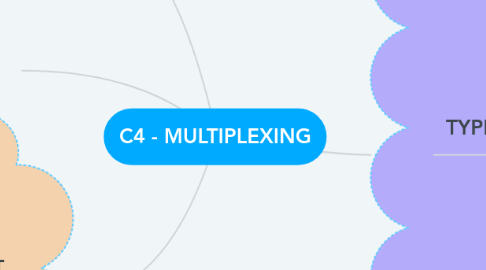
1. WHAT IS MULTIPLEXING?
1.1. A set of techniques that allows the transmission of multiple signals across a single data link.
1.1.1. In a multiplexed system, n devices share the capacity of one link.
1.1.1.1. Link – physical link
1.1.1.2. Channel – portion of a link
2. EMPTY SLOTS
2.1. Empty slot is a case in which one of the input lines has no data to send or one of the input line has discontinuous data.
3. DATA RATE MANAGEMENT
3.1. Techniques to handle a disparity in the input data rates:
3.1.1. i. Multilevel Multiplexing Technique used when data rate of an input line is a multiple of others.
3.1.2. ii.Multiple-Slot Allocation Sometimes it is more efficient to allot more than one slot in a frame to a single input line.
3.1.3. iii.Pulse Stuffing Sometimes the bit rates of sources are not multiple integers of each other. Solution : Make the highest input data rate the dominant data rate and then add dummy bits to the input lines with lower rates.
4. TYPES OF MULTIPLEXING
4.1. ANALOG = Frequency-division multiplexing
4.1.1. FDM is an analog technique that can be applied when the bandwidth of a link (Hz) is greater than the combined bandwidths of the signals to be transmitted.
4.1.2. FDM is an analog multiplexing technique that combines analog signals become one composite signal.
4.1.3. In FDM, channels separated by strips of unused bandwidth (guard bands) to prevent signals from overlapping.
4.1.3.1. To maximize the efficiency of company infrastructure.
4.1.4. THE ANALOG HIERARCHY
4.1.4.1. Example :
4.1.4.1.1. Group (12 voice channels, 48 KHz)
4.1.4.1.2. Super groups (5 groups, 240 KHz, 60 voice channels)
4.1.4.1.3. Master groups (10 super groups, 2.4 MHz, 600 voice channels)
4.1.4.1.4. Jumbo groups (6 master groups, 14.4 MHz, 3600 voice channels)
4.1.5. OTHER APPLICATION OF FDM
4.1.5.1. A familiar application of FDM is cable television and AM and FM radio broadcasting.
4.1.5.2. The coaxial cable used has a bandwidth of approximately 500 MHz.
4.1.5.3. Individually television channel requires about 6 MHz (theoretically 83 channels provided by coaxial).
4.1.5.4. A DEMUX at our television allow us to select which of those channels we wish to receive.
4.2. ANALOG = Wavelength-division multiplexing
4.2.1. Conceptually the same as FDM, except that the multiplexing and demultiplexing involve optical signals transmitted through fiber-optic channels.
4.2.2. The light are multiplexed and demultiplexed by using a prism.
4.2.3. A new method, DWDM (dense WDM) can multiplex a very large number of channels by spacing channels closer to one another. It achieves even greater efficiency.
4.3. DIGITAL = Time-division multiplexing
4.3.1. Combining several low data-rate channels into one high-rate one.
4.3.2. FDM – bandwidth is shared , TDM – time is shared.
4.3.3. Link is sectioned by time.
4.3.4. SYNCHRONOUS TDM
4.3.4.1. In synchronous TDM, each input occupies one time slot and occupies one output time slot.
4.3.4.2. Time slots are grouped into frames that consists of one complete cycle of time slots.
4.3.4.3. In a system with n input lines, each frame has n slots, with each slot allocated data from a specific input line.
4.3.5. STATISTICAL TIME-DIVISION MULTIPLEXING
4.3.5.1. In statistical TDM, slots are dynamically allocated to improve bandwidth efficiency.
4.3.5.2. In statistical multiplexing, the number slots in each frame is less than the number of input lines.
